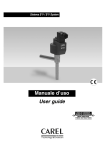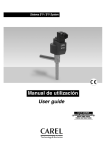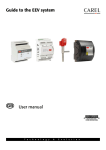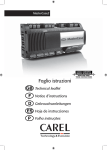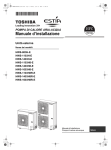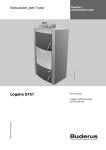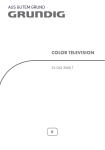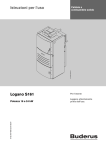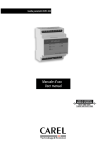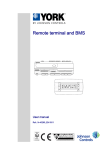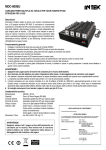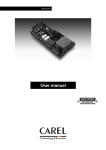Download User guide Manuale d'uso
Transcript
Sistema E 2V / E 2V System Manuale d’uso User guide LEGGI E CONSERVA QUESTE ISTRUZIONI READ AND SAVE THESE INSTRUCTIONS 2 Vogliamo farvi risparmiare tempo e denaro! Vi assicuriamo che la completa lettura di questo manuale vi garantirà una corretta installazione ed un sicuro utilizzo del prodotto descritto. We wish to save you time and money! LEGGI E CONSERVA QUESTE ISTRUZIONI READ AND SAVE THESE INSTRUCTIONS AVVERTENZE IMPORTANTI We can assure you that the thorough reading of this manual will guarantee correct installation and safe use of the product described. IMPORTANT WARNINGS PRIMA DI INSTALLARE O INTERVENIRE SULL’APPARECCHIO, LEGGERE ATTENTAMENTE E SEGUIRE LE ISTRUZIONI CONTENUTE IN QUESTO MANUALE E NEL FOGLIO ISTRUZIONI ALLEGATO AL PRODOTTO. BEFORE INSTALLING OR OPERATING ON THE APPLIANCE, CAREFULLY READ THE INSTRUCTIONS IN THIS MANUAL AND ON THE INSTRUCTION SHEET ENCLOSED WITH THE PRODUCT. Questa apparecchiatura è stata costruita per funzionare senza rischi per gli scopi prefissati purché: • l’installazione, la conduzione e la manutenzione siano eseguite secondo le istruzioni contenute in questo manuale ed il foglio istruzioni allegato al prodotto; • le condizioni dell’ambiente, le pressioni operative e le tensioni di alimentazione rientrino tra quelle specificate nel foglio istruzioni. This equipment has been designed to operate without risks for the specific purpose, as long as: • the installation, operation and maintenance are performed according to the instructions in this manual and on the instruction sheet enclosed with the product; • the environmental conditions, the operating pressure and the power supply voltages fall within the values specified on the instruction sheet. Sarà quindi cura dell’utilizzatore verificare che le caratteristiche riportate siano compatibili con le condizioni operative di impiego. The user is responsible for checking that the characteristics described are compatible with the operating conditions. Ogni utilizzo diverso da questo e l’apporto di modifiche, non espressamente autorizzate dal costruttore, sono da intendersi impropri. Any other use or changes which have not been previously authorised by the manufacturer, are considered improper. La responsabilità di lesioni o danni causati da uso improprio ricadrà esclusivamente sull’utilizzatore. Liability for injures or damage caused by improper use lies exclusively with the user. Si osservi che questo prodotto contiene componenti elettrici sotto tensione e parti in pressione positiva e quindi tutte le operazioni di servizio o manutenzione devono essere condotte da personale esperto e qualificato, cosciente delle necessarie precauzioni. Note that some electrical components of this instrument are live and some parts are under pressure, thus all the service or maintenance operations must be performed by expert and skilled personnel only, aware of the necessary precautions. Prima di accedere alle parti interne sezionare la macchina dalla rete elettrica ed azzerare il differenziale di pressione con l’ambiente esterno. Before accessing the internal parts, disconnect the power supply and restore the pressure to that of the surrounding environment. Smaltimento delle parti: Le valvole E2V sono composte da parti in metallo e da parti in plastica. Tutte queste parti vanno smaltite secondo le Normative locali in materia di smaltimento. Disposal of the parts The E2V valves are made up of metal and plastic parts. must be disposed of according to the local legislation in force on waste disposal. 3 E2V - cod. +030220215 rel. 1.0 - 19.09.03 4 INDICE 1. 2. 2.1 CONTENTS 7 8 8 9 10 1. 2. 2.1 2.2 INTRODUZIONE Scelta E2V Informazioni sull’impianto e condizioni operative Scelta rapida Scelta da tabelle 3. 3.1 3.2 3.3 3.4 3.5 3.6 INSTALLAZIONE E V Layout del sistema frigorifero Flusso del refrigerante e orientamento spaziale valvola Procedura di saldatura Connessioni elettriche (avvolgimento) Filtro in linea Ulteriori raccomandazioni importanti 17 17 17 18 18 19 19 4. 4.1 4.2 4.3 INSTALLAZIONE SONDE DI TEMPERATURA E PRESSIONE Posizione ottimale delle sonde Installazione della sonda di temperatura Installazione sonda di pressione 20 20 22 24 5. 5.1 5.2 5.3 COLLEGAMENTI CONTROLLO Fasi motore E2V Ingresso digitale Sonde di temperatura e di pressione 6. 6.1 6.2 6.3 7. 7.1 7.2 2.2 INTRODUCTION Selecting the E2V Information on installation and normal operating conditions Quick selection guide How to use the tables 7 8 8 9 10 3. 3.1 3.2 3.3 3.4 3.5 3.6 INSTALLING THE E2V Refrigeration system layout Refrigerant flow and spatial orientation of the valve Welding procedure Electrical connections (coil) In-line filter Other important recommendations 17 17 17 18 18 19 19 4. 4.1 4.2 4.3 INSTALLING THE TEMPERATURE AND PRESSURE PROBE Ideal position of the probes Installing the temperature probe Installing the pressure probe 20 20 22 24 25 25 25 26 5. 5.1 5.2 5.3 CONTROL CONNECTIONS E2V motor phases Digital input Temperature and pressure probe 25 25 25 26 CONFIGURAZIONE PARAMETRI Parametri per valvola di espansione Parametri di sistema Parametri di regolazione 27 27 27 27 6. 6.1 6.2 6.3 CONFIGURING THE PARAMETERS Expansion valve parameters System parameters Control parameters 27 27 27 27 START-UP E PRIMO DEBUG DEL SISTEMA E2V Start-up Debug installazione 7. 29 29 29 START-UP AND INITIAL TROUBLESHOOTING OF THE E2V SYSTEM Start-up Troubleshooting 29 29 29 2 7.1 7.2 5 E2V - cod. +030220215 rel. 1.0 - 19.09.03 6 1. INTRODUZIONE 1. INTRODUCTION Questo manuale tratta l’installazione della valvola di espansione Carel E2V e degli altri componenti del sistema necessari al suo funzionamento: sonde di pressione e temperatura con cenni al driver di pilotaggio della valvola, sia esso di tipo built-in nel controllo dell’unità frigorifera utilizzato o di tipo esterno collegato via rete di supervisione e/o via contatto digitale con il controllo di unità di cui sopra. This manual describes the installation of the Carel E2V expansion valve and the other components in the system required for its operation pressure and temperature probes - with mention also made of the valve control driver, either integrated into the refrigeration unit controller, or external and connected via a supervisory network and/or digital contact to the controller. Le informazioni possono essere utilizzate per l’installazione di qualunque sistema Carel per il pilotaggio di ogni valvola di espansione elettronica (EEV – Electronic Expansion Valve) compatibile con il controllo in proprio possesso. This information may be used for the installation of any Carel system for the control of electronic expansion valves (EEV) that are compatible with the controller in question. Le istruzioni relative alla messa in opera della valvola vanno ovviamente sostituite con quelle della valvola utilizzata, se diversa dalla Carel E2V: per queste informazioni riferirsi sempre alla documentazione del proprio fornitore. The instructions relating to the setting up of the valve should be naturally be replaced with those corresponding to the actual valve used, if this is not the Carel E2V: for this information, refer to the documents provided by the supplier of the valve. Per informazioni dettagliate sull’installazione, setup ed utilizzo del proprio driver consultare la relativa documentazione. Il generico sistema Carel per il pilotaggio di una EEV è costituito da: For detailed information on the installation, setup and operation of the driver, refer to the corresponding documents. The generic Carel EEV control system is made up of the following components: • • • • • Expansion valve • Temperature probe • Pressure probe • Driver and/or controller Valvola di espansione Sonda di temperatura Sonda di pressione Driver e/o controllo di pilotaggio LEGGERE E SEGUIRE CON ATTENZIONE LE ISTRUZIONI RIPORTATE DURANTE LA SELEZIONE, MESSA IN OPERA E FUNZIONAMENTO DELLE VALVOLE DI ESPANSIONE ELETTRONICHE E2V. CAREFULLY READ AND FOLLOW THE INSTRUCTIONS PROVIDED WHEN SELECTING, SETTING UP AND OPERATING THE E2V ELECTRONIC EXPANSION VALVE. UN’INSTALLAZIONE NON CORRETTA PUÒ PORTARE AD INCONVENIENTI COME IL DANNEGGIAMENTO DELLE VALVOLE E2V STESSE O DELL’UNITÀ IN CUI SONO INSTALLATE E AD UNA REGOLAZIONE NON OTTIMALE. INCORRECT INSTALLATION MAY CAUSE PROBLEMS SUCH AS DAMAGE TO THE E2V VALVES OR THE UNIT THESE ARE INSTALLED IN, OR POOR CONTROL. PER LE SPECIFICHE OPERATIVE ED I LIMITI DI UTILIZZO DELLE VALVOLE E2V FARE SEMPRE RIFERIMENTO AL FOGLIO ISTRUZIONI CHE LE ACCOMPAGNA. SARÀ QUINDI CURA DELL’UTILIZZATORE VERIFICARE CHE LE CARATTERISTICHE RIPORTATE SIANO COMPATIBILI CON LE CONDIZIONI OPERATIVE DI IMPIEGO. FOR THE OPERATING SPECIFICATIONS AND THE LIMITS OF USE OF THE E2V VALVES, ALWAYS REFER TO THE INSTRUCTION SHEET SUPPLIED WITH THE VALVE. THE USER IS RESPONSIBLE FOR CHECKING THAT THE CHARACTERISTICS DESCRIBED ARE COMPATIBLE WITH THE OPERATING CONDITIONS. CAREL DECLINA OGNI TIPO DI RESPONSABILITÀ PER MALFUNZIONAMENTO E/O DANNEGGIAMENTO DELLE VALVOLE E2V ED I DANNI A COSE E PERSONE DERIVANTI DALL’ USO IMPROPRIO DELLE VALVOLE STESSE; L’USO IMPROPRIO COMPRENDE MA NON SI LIMITA AL PILOTAGGIO DELLE VALVOLE E2V TRAMITE DISPOSITIVI NON CAREL O NON OGGETTO DI PREVIO RICONOSCIMENTO DI COMPATIBILITÀ DA PARTE DI CAREL STESSA E ALL’UTILIZZO PER SCOPI E/O CON MODALITÀ E/O INSTALLAZIONI DIVERSE DA QUELLE PERMESSE E CONSIGLIATE DA CAREL. CAREL DECLINES ALL LIABILITY FOR ANY MALFUNCTIONS AND/OR DAMAGE TO THE E2V VALVES AND DAMAGE TO PERSONS AND THINGS DUE TO THE IMPROPER USE OF THE VALVES; IMPROPER USE INCLUDES BUT IS NOT LIMITED TO THE CONTROL OF THE E2V VALVES BY DEVICES NOT SUPPLIED BY CAREL OR NOT RECOGNISED AS BEING COMPATIBLE BY CAREL, AS WELL AS USE FOR PURPOSES AND/OR IN WAYS AND/OR IN INSTALLATIONS OTHER THAN THOSE ALLOWED AND RECOMMENDED BY CAREL 7 E2V - cod. +030220215 rel. 1.0 - 19.09.03 2. SCELTA E2V 2. SELECTING THE E2V 2.1 Informazioni sull’impianto e condizioni operative 2.1 Information on installation and normal operating conditions Prima di procedere alla selezione della taglia di E2V, la relativa installazione e l’impostazione dei parametri di configurazione del Driver/Controllo utilizzato, è consigliabile recuperare ed avere a disposizione alcune informazioni fondamentali sull’unità frigorifera in cui sta per essere istallato il sistema Carel di regolazione E2V. Before selecting the size of the E2V, installing and setting the configuration parameters of the Driver/Controller used, the user should acquire some fundamental information on the refrigeration unit that the Carel E2V control system is to be installed IN. Le informazioni necessarie sono: • Refrigerante • Potenza frigorifera del compressore (o dell’evaporatore nel caso di utenze centralizzate come banchi frigoriferi e celle) con temperature sature di condensazione e di evaporazione cui la potenza frigorifera si riferisce. • Perdite di carico tra il punto in cui è misurata la pressione di condensazione e l’ingresso della valvola di espansione. • Perdite di carico tra l’uscita della valvola e il punto in cui è misurata la pressione di evaporazione. • Potenza frigorifera della valvola di espansione E2V nelle condizioni di cui sopra: per lo scopo riferirsi alle tabelle di selezione delle E2V o meglio al software di selezione disponibile a richiesta. • Sottoraffreddamento (differenza tra temperatura termometrica e manometrica) all’ingresso della valvola di espansione. • Considerare in questi calcoli (compressore/evaporatore/valvola) tutte le possibili condizioni di impiego con speciale riguardo alla temperatura di condensazione se è prevista una gestione flottante della stessa: questo per evitare che la valvola selezionata sia sottodimensionata o sovradimensionata. • Estremi della temperatura di evaporazione (minimo e massimo previsti nel funzionamento della propria unità) per la determinazione dei limiti alle funzioni di LOP (Lowest Operating Pressure – Minima pressione di evaporazione) e MOP (Maximum Operating Pressure –Massima pressione di evaporazione) se si prevede che verranno utilizzate. The following information is required: • Refrigerant • Cooling capacity of the compressor (or the evaporator, in the case of centralised utilities such as showcases and cold rooms), with the saturated condensing and evaporating temperatures that the cooling capacity refers to. • Pressure drop between the point where the condensing pressure is measured and the intake of the expansion valve. • Pressure drop between the outlet of the valve and the point where the evaporation pressure is measured. • Cooling capacity of the E2V expansion valve in the above conditions: for this purpose, refer to the E2V selection tables, or better still use the selection software, available on request. Per un dimensionamento preciso utilizzare il software di selezione E2V Selection o la procedura di calcolo riportata in seguito per le tabelle E2V Maximum cooling capacity. L’uso della valvola è possibile per una resa variabile tra il 10% e il 100% dell’apertura massima e la portata di refrigerante aumenta linearmente con l’apertura. Nonostante l’estesa capacità di modulazione delle valvole E2V è sempre consigliabile la selezione di una taglia prossima alle esigenze del proprio impianto al fine di una migliore regolazione. For precise sizing, use the E2V Selection software or the calculation procedure shown below for the E2V Maximum cooling capacity tables. The valve can be used for a capacity varying between 10% and 100% of maximum opening, with the flow-rate of refrigerant increasing linearly with the opening of the valve. Despite the extended modulation capacity of the E2V valves, it is always recommended to select a size as near as possible to the requirements of the installation to ensure better control. • Subcooling (difference between the thermometric and manometric temperature) at the intake of the expansion valve. • In these calculations (compressor/evaporator/valve), consider all the possible operating conditions, with special regard to the condensing temperature if floating-type control is envisaged: this will avoid the valve selected being over- or under-sized. • Extremes in the evaporation temperature (minimum and maximum envisaged for the operation of the unit) so as to determine the LOP (Lowest Operating Pressure) and MOP (Maximum Operating Pressure), if these are used. 8 E2V - cod. +030220215 rel. 1.0 - 19.09.03 Scelta rapida Si riportano di seguito le rese in kW in varie condizioni, tutti i dati sono riferiti a: • 80%di apertura • 0.5 bar di perdite di carico prima della valvola di espansione (condensatore + linea del liquido) • 0.5 bar di perdite di carico dopo la valvola di espansione (distributore + evaporatore) • 5 °C di sottoraffreddamento. Quick selection guide The following are the capacities in kW in various conditions; all the data refer to: • 80% opening • 0.5 bar pressure drop upstream of the expansion valve (condenser + liquid line) • 0.5 bar pressure drop downstream of the expansion valve (distributor + evaporator) • 5 °C subcooling. CONDIZIONAMENTO AIR-CONDITIONING Apertura 80% 80% opening Temperatura di condensazione = 50 °C Condensing temperature = 50 °C R22 E2V-09 E2V-11 E2V-14 E2V-18 E2V-24 E2V-30 E2V-35 kW 3.4 4.9 7.6 12.4 21.6 33.2 44.7 R134a Kg/h 81 117 182 297 517 794 1070 kW 2.7 3.8 6 9.7 16.9 26 35 Temperatura di evaporazione = 5 °C Evaporation temperature = 5 °C R404a Kg/h 70 100 156 255 443 680 916 kW 2.2 3.2 4.9 8 14 21.4 28.9 R410a Kg/h 80 115 180 293 511 785 1058 kW 3.9 5.7 8.8 14.4 25 38.5 51.8 R407c Kg/h 93 134 209 341 594 912 1229 kW 3.5 5 7.8 12.6 22 33.8 45.5 R507c Kg/h 81 117 183 297 518 795 1071 kW 2.2 3.1 4.8 7.9 13.7 21.1 28.4 Kg/h 81.4 117 183 297 518 796 1072 Tab. 2.1.1 REFRIGERAZIONE BT BT REFRIGERATION Apertura 80% 80% opening Temperatura di condensazione = 40°C Condensing temperature = 40°C R22 E2V-09 E2V-11 E2V-14 E2V-18 E2V-24 E2V-30 E2V-35 kW 3.4 4.8 7.6 12.3 21.4 32.9 44.3 R134a Kg/h 83 119 186 304 529 813 1095 kW - Temperatura di evaporazione = -40°C Evaporation temperature = -40°C R404a Kg/h - kW 2.1 3 4.7 7.6 13.2 20.3 27.4 R410a Kg/h 83 119 186 304 529 813 1096 kW 4.1 5.8 9.1 14.8 25.8 39.6 53.4 R407c Kg/h 96 139 217 353 614 944 1272 kW 3.3 4.7 7.4 12 20.8 32 43.1 R507c Kg/h 81 117 183 299 520 799 1076 kW 2.1 3 4.7 7.6 13.2 20.3 27.3 Kg/h 84 122 190 310 539 829 1117 Tab. 2.1.2 REFRIGERAZIONE MT MT REFRIGERATION Apertura 80% 80% opening Temperatura di condensazione = 40°C Condensing temperature = 40°C R22 E2V-09 E2V-11 E2V-14 E2V-18 E2V-24 E2V-30 E2V-35 kW 3.4 4.9 7.6 12.3 21.4 32.9 44.4 R134a Kg/h 77 111 174 284 494 759 1023 kW 2.6 3.7 5.7 9.3 16.3 25 33.6 Temperatura di evaporazione = -15°C Evaporation temperature = -15°C R404a Kg/h 65 94 146 239 416 639 860 kW 2.3 3.3 5.1 8.3 14.5 22.2 30 R410a Kg/h 77 111 174 284 494 759 1023 kW 4.1 5.9 9.2 15 26.1 40 54 R407c Kg/h 90 130 203 330 575 883 1190 kW 3.4 4.9 7.7 12.5 21.7 33.3 44.9 R507c Kg/h 76 110 172 281 489 751 1012 kW 2.2 3.2 5 8.2 14.3 21.9 29.5 Kg/h 79 114 177 289 503 773 1042 Tab. 2.1.3 9 E2V - cod. +030220215 rel. 1.0 - 19.09.03 2.2 Scelta da tabelle 2.2 How to use the tables 1. Noto il refrigerante scegliere il foglio corrispondente. 2. Con la temperatura di evaporazione satura Te (°C) selezionare la tabella corrispondente. 3. Con la temperatura di condensazione satura Tc (°C) determinare la riga corrispondente. 4. Con il sottoraffreddamento SBC (°C) all’ingresso della valvola E2V determinare il fattore correttivo “Ksbc”. Approssimare sempre per difetto. 5. Con le perdite di carico cumulative della linea del gas e del liquido determinare il fattore correttivo “J”. Approssimare sempre per eccesso. 6. Nota la capacità frigorifera dell’evaporatore/compressore Q0 (kW) determinare la capacità richiesta alla valvola Qvalve (kW) utilizzando la formula seguente: 1. Choose the sheet corresponding to the refrigerant used. 2. Use the saturated evaporation temperature Te (°C) to determine the table to use. 3. Use the saturated condensing temperature Tc (°C) to determine the corresponding row. 4. Use the subcooling SBC (°C) at the intake of the E2V valve to determine the correction factor “Ksbc”. Always round down. 5. Use the cumulative pressure drop in the gas and liquid line to determine the correction factor “J”. Always round up 6. Use the cooling capacity of the evaporator/compressor Q0 (kW) to determine the required capacity of the valve Qvalve (kW), with the following formula: 7. Selezionare quindi una valvola nella tabella che nelle condizioni operative scelte presenti una capacità UGUALE o SUPERIORE a quella calcolata. 8. Nel caso in cui le condizioni di temperatura non siano presenti nelle tabelle è consentito il calcolo tramite media aritmetica tra i valori presenti. 7. Then select a valve from the table that in normal operating conditions has a capacity that is greater than or equal to the value calculated. 8. If the temperature conditions are not listed in the tables, calculate the arithmetic average of the values listed. Attenzione: nel caso si utilizzino condizioni operative (Tc, Te, kW, …) flottanti ripetere questa procedura per ogni condizione prevista per il proprio impianto per verificare che la capacità della valvola scelta non sia in alcuni casi insufficiente o eccessiva. Warning: in the event of floating operation (Tc, Te, kW, …), repeat this procedure for all conditions envisaged in the installation, so as to ensure that the capacity of the selected valve is not insufficient or excessive in certain cases. Esempio di dimensionamento Compressore per R407c con resa di 10kW frigoriferi a 5 °C di temperatura di evaporazione e 46 °C di temperatura di condensazione operante a 10°C di sottoraffreddamento (SBC) e con 0.5 bar di perdite di carico nella linea del liquido e 0.3 bar sulla linea del gas. Riferendosi alla tabella relativa al R407c e alla temperatura di 5 °C non è presente la riga corrispondente alla temperatura di condensazione di 46 °C: verrà quindi considerata la media aritmetica dei valori delle righe relative a 44 °C e 48 °C. Il fattore K per il sottoraffreddamento sarà quindi anch’esso la media del K10 °C a 44 °C (1.05) e del K10 °C a 48 °C (1.08) cioè 1.065. Il totale delle perdite di carico è di 0.3 bar+0.5 bar=0.8 bar che approssimato a 1 bar mi da un coefficiente correttivo per le perdite di carico di 0.96. La capacità da cercare nei valori in kW riportati è quindi di: 10/(0.96 x 1.065)= 9.78 kW e la valvola più idonea da selezionare è una E2V-18 che presenta una capacità di 14.6 kW risultanti dalla media di 14.4 kW (riferito a 46 °C) e 14.6 kW (riferito a 48 °C). La valvola nelle condizioni considerate risulterà aperta circa al 70% Example Compressor operating on R407c with a cooling capacity of 10kW at an evaporation temperature of 5 °C and a condensing temperature of 46 °C, operating with a subcooling (SBC) of 10 °C and a 0.5 bar pressure drop in the liquid line and 0.3 bar pressure drop in the gas line. In the table corresponding to R407c and the evaporation temperature of 5 °C, there is no row corresponding to a condensing temperature of 46 °C: consequently, the average arithmetic of the values in the rows corresponding to 44 °C and 48 °C will be used. The K factor for the subcooling will therefore be the average between K10 °C at 44 °C (1.05) and K10 °C at 48 °C (1.08), that is, 1.065. The total pressure drop is 0.3 bar+0.5 bar=0.8 bar, rounded up to 1 bar, giving a correction coefficient for the pressure drop of 0.96. The capacity sought after in the tables, in kW, is therefore: 10/(0.96 x 1.065)=9.78 kW, and consequently the most suitable valve is an E2V-18, with a capacity of 14.6 kW, the average between 14.4 kW (referring to 44 °C) and 14.6 kW (referring to 48 °C). The valve, in the conditions considered above, will be around 70% open. 10 E2V - cod. +030220215 rel. 1.0 - 19.09.03 Tab. 2.2.1 11 E2V - cod. +030220215 rel. 1.0 - 19.09.03 Tab. 2.2.2 12 E2V - cod. +030220215 rel. 1.0 - 19.09.03 Tab. 2.2.3 13 E2V - cod. +030220215 rel. 1.0 - 19.09.03 Tab. 2.2.4 14 E2V - cod. +030220215 rel. 1.0 - 19.09.03 Tab. 2.2.5 15 E2V - cod. +030220215 rel. 1.0 - 19.09.03 Tab. 2.2.6 16 E2V - cod. +030220215 rel. 1.0 - 19.09.03 3. INSTALLAZIONE E2V 3. INSTALLING THE E2V 3.1 Layout del sistema frigorifero 3.1 Refrigeration system layout Si riporta di seguito uno schema indicativo del sistema con componenti sempre presenti ed opzionali con indicata la posizione tipica per la valvola E2V e dei sensori necessari al calcolo del surriscaldamento. The following is a typical diagram of the system, with the components that are always present and the optional components, showing the typical position of the E2V valve and the sensors required to calculate the superheat. Fig. 3.1.1 3.2 Flusso del refrigerante e orientamento spaziale valvola 3.2 Refrigerant flow and spatial orientation of the valve Il verso di connessione consigliato (prima figura) è con l’ingresso laterale alla valvola anche se le valvole Carel E2V sono di tipo bidirezionale fino ad un differenziale di pressione indicato nel relativo foglio istruzioni. The recommended direction of connection (first figure) is with the intake to the side of the valve, even if the Carel E2V valves are bi-directional, up to a pressure differential indicated in the instruction sheet. Fig. 3.2.1 Attention: Never install the valve upside down, that is, with the stator pointing downwards. Attenzione: Non è in nessun caso consentita l’installazione capovolta ossia con lo statore rivolto verso il basso. Fig. 3.2.2 17 E2V - cod. +030220215 rel. 1.0 - 19.09.03 3.3 Procedura di saldatura 3.3 Welding procedure Le connessioni possono essere o a saldare, in acciaio (solo 10 mm per entrambi i raccordi) o in rame (tasche per 10 mm, 12 mm, 16 mm, 18 mm ODF) o a raccordare (raccordi 3/8”, 1/2", 5/8” SAE) a seconda del codice di valvola E2V in vostro possesso. 1. Svitare il dado di chiusura dello statore (avvolgimento) e sfilarlo. Eventualmente scollegare il connettore se dovesse essere inserito. 2. Prima di procedere alla saldatura avvolgere il corpo della valvola (privo di statore) con uno straccio bagnato per evitare il surriscaldamento delle parti interne. 3. A fine saldatura reinserire lo statore ed avvitare il dado di chiusura valvola-statore. The welded connections may be steel (10 mm only for both connectors) or copper (with 10 mm, 12 mm, 16 mm, 18 mm ODF connections) or pipe fittings (3/8”, 1/2", 5/8” SAE fittings), depending on the code of the E2V in question. 1. Unscrew the nut that secures the stator (coil) and remove the stator. If necessary, remove the connector, if inserted. 2. Before proceeding with the welding, wrap the body of the valve (without the stator) in a wet rag, so as avoid overheating the parts inside. 3. At the end of the welding procedure, replace the stator and tighten valve-stator locking nut. Fig. 3.3.1 Attenzione: Evitare l’ingresso di acqua o altri corpi/fluidi estranei all’interno della valvola: sarebbe poi impossibile procedere ad una pulizia completa delle parti interne. • Non orientare per nessun motivo la fiamma verso la valvola né in fase di installazione né con la E2V in opera. • Non avvicinare la valvola a magneti e/o campi magnetici. • Non esercitare eccessiva pressione sullo statore quando viene calzato sulla E2V per evitare deformazioni della calotta plastica di rivestimento in coda allo statore. Attention: Do not let water or other foreign bodies/fluids inside the valve: this would make it impossible to completely clean the parts inside. • Never point the flame towards the valve, either during installation or with the E2V in operation. • Never place the valve near magnets and/or magnetic fields. • Do not exert excessive pressure on the stator when fitting it to the E2V, so as to avoid deforming the plastic cap at the bottom of the stator. a c b Fig. 3.3.1 3.4 Connessioni elettriche (avvolgimento) 3.4 Electrical connections (coil) Collegare un cavo quadripolare al connettore E2VC0N* secondo lo schema sotto riportato. Connect a four-wire cable to the connector, E2VC0N* as per the diagram shown below. Fig. 3.4.1 La connessione è di tipo standard DIN 43650. A standard DIN 43650 connection is used. 18 E2V - cod. +030220215 rel. 1.0 - 19.09.03 Per le fasi motore si consigliano conduttori AWG18-22 mentre il cavo quadripolare deve avere un diametro esterno da 4 a 6 mm per consentire un’adeguata presa della guarnizione esterna. La tenuta idraulica massima fornita dai connettori a cablare forniti da Carel (E2VCON*) corrisponde ad un IP65. Fissare con la relativa vite il connettore con la guarnizione senza esercitare un’eccessiva pressione: se si dovesse infatti avvertire una certa resistenza è probabile che il verso di inserimento del connettore non sia corretto. Attenzione: Non esercitare quindi un’eccessiva pressione prima di aver controllato la corrispondenza del pin più largo (targato sulla E2V con il simbolo di terra) sulla basetta a bordo valvola con il relativo foro sul connettore. Riferirsi allo schema sottostante per il collegamento del sistema statore-connettore-cavo. Alternativamente è possibile utilizzare dei cavi sovrastampati al connettore IP67 (E2VCAB*) forniti da Carel per specifiche esigenze in particolari condizioni operative e/o esterne come temperature negative in display cabinet, celle frigorifere ecc. For the motor phases, AWG18-22 wires should be used, while the fourwire cable must have an outside diameter of between 4 and 6mm so as to ensure adequate grip on the outer gasket. The maximum index of protection of the wiring connectors supplied by Carel (E2VCON*) is IP65. Secure the connector with the gasket, using the screw, without exerting excessive pressure: if there is a certain resistance, it is probable that the connector has not been inserted in the right way. 3.5 Filtro in linea 3.5 In-line filter In tutte le applicazioni ed in particolare in grandi impianti di utenze centralizzate (supermercati ecc) è fortemente consigliata l’installazione di un filtro in linea eventualmente ispezionabile (a cartuccia, raccordato,…) prima dell’ingresso del refrigerante nella valvola E2V per il blocco delle impurità che potrebbero pregiudicare il funzionamento della valvola stessa anche dopo poco tempo. Se è prevista un’istallazione bidirezionale (flusso di refrigerante in entrambe le direzioni in una pompa di calore reversibile) è da prevedere l’uso di un filtro bidirezionale (liquido/gas) su entrambe le connessioni della valvola di espansione o altre soluzioni impiantistiche a seconda del layout del proprio impianto. In all applications, and in particular in large systems of centralised utilities (supermarkets etc.), it is strongly recommended to install an in-line filter, ideally an openable model (cartridge, screw on,…) upstream of the refrigerant inlet to the E2V valve, so as to trap any impurities that may affect the operation of the valve, even after a short time. If bi-directional installation is envisaged (refrigerant flow in both directions, for reverse cycle heat pumps), a bi-directional (liquid/gas) filter must be used on both connections to the expansion valve, or other similar solutions depending on the layout of the installation. Attention: Never exert excessive pressure before having checked that the wider pin (marked on the E2V with the earth symbol) on the base of the valve matches the corresponding slot on the connector. Refer to the diagram below for the connection of the stator-connector-cable system. Alternatively, over-moulded cables can be connected to the IP67 connector (E2VCAB*) supplied by Carel for specific requirements in special operating and/or outside conditions, such as below-zero temperatures in the display cabinet, cold rooms, etc. Fig. 3.5.1 3.6 Ulteriori raccomandazioni importanti 3.6 Other important recommendations • Non procedere all’installazione o all’uso in caso di deformazione o danneggiamento delle parti visibili (calotta esterna e tubi di connessione). • Non procedere all’installazione o all’uso in caso di forte impatto dovuto per esempio a caduta. • Non procedere all’installazione o all’uso in caso di danneggiamento della parte statore (avvolgimento), della basetta portacontatti o del connettore. • Do not install or operate the valve in the event of deformation or damage to the visible parts (external cap and connection pipes). • Do not install or operate the valve following strong impact, for example after having been dropped. • Do not install or operate the valve in the event of damage to the stator (coil), the contacts on the base or the connector. 19 E2V - cod. +030220215 rel. 1.0 - 19.09.03 4. INSTALLAZIONE SONDE DI TEMPERATURA E PRESSIONE 4. INSTALLING THE TEMPERATURE AND PRESSURE PROBES 4.1 Posizione ottimale delle sonde 4.1 Ideal position of the probes I sensori di temperatura e di pressione vanno installati il più vicino possibile tra di loro ed immediatamente a valle dell’evaporatore, in un tratto della tubazione di aspirazione possibilmente rettilineo. In caso di tratti di tubazione verticale tra uscita evaporatore e compressore (o uscita banco centralizzato), installarli possibilmente prima del primo tratto verticale. The temperature and pressure sensors should be installed as near as possible to each other and immediately downstream of the evaporator, ideally in a straight section of the intake pipe. If the sections of pipe between the evaporator outlet and the compressor (or centralised cabinet outlet) are vertical, install the sensors before the first vertical section, where possible. Fig. 4.1.1 Fig. 4.1.2 4.1.1 Ambienti a temperatura negativa È possibile in questi casi installare i due sensori fino ad un metro di distanza dall’uscita dell’evaporatore in modo da uscire dalla zona a bassa temperatura (celle refrigerate o banchi per esposizione) e facilitare le operazioni di ispezione e sostituzione. 4.1.1 Environments with below-zero temperatures In these cases, the two sensors can be installed up to one metre from the evaporator outlet, so as to be outside of the low temperature zone (cold rooms or showcases) and assist the inspection and replacement operations. Fig. 4.1.1.1 20 E2V - cod. +030220215 rel. 1.0 - 19.09.03 Considerare comunque che: a) La regolazione peggiora leggermente in termini di accuratezza e di stabilità. Sarebbero quindi consigliate alcune prove di funzionamento. b) Il tratto tra l’uscita dell’evaporatore e la posizione dei due sensori deve essere libero da ogni dispositivo che alteri pressione e/o temperatura come valvole di intercettazione, scambiatori di calore, ecc. Nel caso esista qualche dispositivo di questo tipo tra uscita evaporatore e sensori la regolazione verrebbe seriamente compromessa. In any case, the following should be noted: a) Control will be affected slightly in terms of accuracy and stability. Some operating tests should therefore be performed. b) The section between the evaporator outlet and the position of the two sensors must be free of any device that alters the pressure and/or temperature, such as on-off valves, heat exchangers, etc. 4.1.2 Presenza di scambiatore di calore liquido-gas (es. banchi refrigerati) Nel caso esista uno scambiatore di calore liquido-gas è necessario installare i sensori di temperatura e pressione nella tubazione del gas prima dell’ingresso nello scambiatore stesso. 4.1.2 Presence of a liquid-gas heat exchanger (e.g. refrigerated showcases) If a liquid-gas heat exchanger is present, the temperature and pressure sensors must be installed in the gas line, before the inlet to the exchanger. If such a device is installed between the evaporator outlet and sensors, control would be seriously affected. Fig. 4.1.2.1 4.1.3 Pompe di calore reversibili (E2V in funzionamento bidirezionale) In questo caso le sonde di pressione e temperatura vanno installate nel ramo comune in aspirazione (quindi sempre in bassa pressione) del circuito frigorifero. Ovviamente la presenza di valvola di inversione ed altri dispositivi tra uscita evaporatore e posizione delle sonde altera la lettura della pressione e probabilmente anche quella della temperatura. Sono quindi consigliate delle prove per stabilire quali siano i valori dei parametri (set-point, soglie e a volte guadagni PID e protezioni) più opportuni per una regolazione ottimale. 4.1.3 Reverse-cycle heat pumps (E2V in bi-directional operation) In this case, the pressure and temperature probes should be installed in the common suction branch (low pressure) in the refrigerant circuit. Obviously, the presence of reversing valve and other devices between the evaporator outlet and the position of the probes alters the pressure reading, and probably also the temperature reading. Tests should therefore be performed to establish the most suitable values of the parameters (set point, thresholds, PID gain and protection times) for optimum control. Fig. 4.1.3.1 21 E2V - cod. +030220215 rel. 1.0 - 19.09.03 4.2 Installazione della sonda di temperatura 4.2 Installing the temperature probe La sonda di temperatura va installata a +/- 30° dalla verticale e comunque mai sulla parte inferiore della tubazione. The temperature probe should be installed at +/- 30° from the vertical, and in any case never on the lower part of the pipe. Attenzione: Per evitare il danneggimento della sonda a causa di ghiaccio nei cicli di brinamento e sbrinamento cercare di realizzare con il cavo di collegamento un’ansa come indicato in figura. Attention: To avoid damaging the probe due to frost in the freezing and defrost cycles, connect the cable as shown in the figure. NO Fig. 4.2.1 È raccomandato l’uso di pasta conduttiva (1) tra tubazione e sonda ed il rivestimento con un isolante termico (3). Si raccomanda di non utilizzare collanti di nessun tipo per evitare degradazioni del materiale plastico della sonda o del relativo cavo. Conductive paste (1) should be used between the pipe and the probe, as well as heat insulation lining (3). Do not use any types of glue, to avoid deforming the plastic material on the probe or the cable. Fig. 4.2.2 4.2.1 Pozzetto per la sonda di temperatura 4.2.1 Socket for the temperature probe Fig. 4.2.1.1 4.2.1.1 Unità compatte (condizionamento, celle refrigerate, ...) L’installazione del pozzetto è consigliata in primo luogo in sistemi con dinamiche veloci (scambiatori a piastre, circuiti compatti,...) e soprattutto in caso di presenza di compressori non protetti da ricevitori di liquido in aspirazione e/o particolarmente delicati come quelli alternativi (pistoni,...). 4.2.1.1 Compact units (air-conditioning, cold rooms, ...) The socket is recommended above all for systems with fast dynamics (plate exchangers, compact circuits,...) and with compressors not protected by liquid receivers on the suction side and/or particularly delicate compressors, such as reciprocating compressors (pistons,...). 4.2.1.2 Refrigerazione commerciale centralizzata Nel caso, invece, di installazioni assimilabili a banchi per esposizione/celle centralizzati o sistemi dotati di lunghi tratti di 4.2.1.2 Centralised commercial refrigeration In the case of installations such as centralised showcases/cold rooms or systems fitted with long sections of pipes between the evaporator 22 E2V - cod. +030220215 rel. 1.0 - 19.09.03 tubazione tra l’uscita dell’ evaporatore e l’aspirazione del compressore frigorifero è possibile evitare l’installazione del pozzetto considerando comunque che è necessario fare alcune considerazioni sulla dinamica della lettura della temperatura: a. La lettura della componente di temperatura (NTC) del surriscaldamento avrà un offset rispetto al valore reale. Questo significa che il surriscaldamento rilevato dal controllo sarà maggiore di quello reale. Per questo motivo il SETPOINT del surriscaldamento e la soglia della protezione LOW SH andrà aumentato anche di 3 °C rispetto a quello desiderato realmente. Se ad esempio si presume o si riscontra un offset di 2 °C e si imposta il set-point del surriscaldamento a 5 °C la valvola di espansione regolerà il surriscaldamento effettivamente ad un valore letto di 5 °C che corrispondono però a (5-2)=3 °C reali. Se si desidera quindi un surriscaldamento realmente di 5°C il SETPOINT dovrà essere impostato a (5+2)=7 °C. b. Il sistema in questo caso apparirà al controllo della valvola di regolazione più “lento” di come è in realtà e bisogna tenere conto di questo aspetto nell’impostazione dei parametri di regolazione (tempo integrale del regolatore PID e tempi integrali delle protezioni vanno aumentati del 30% o più rispetto a quelli tipici/consigliati nel caso in cui venga utilizzato un pozzetto per la sonda di temperatura). outlet and compressor intake, the socket is not necessarily required, however, some aspects regarding the dynamics of the temperature readings should be considered: a. The reading of the temperature component (NTC) of the superheat will be offset from the actual value. This means that the superheat measured by the controller will be higher than the real value. For this reason, the superheat SET POINT and the LOW SH protection threshold must be increased by 3 °C from the required value. If, for example, an offset of 2 °C is measured or assumed, and the superheat set point is set to 5 °C, the expansion valve will control the superheating to a reading of 5 °C, which however corresponds to (5-2)=3 °C real. To ensure the superheating is actually 5°C, the SET POINT must be set to (5+2)=7 °C. b. The system in this case will seem “slower” to the valve controller than is actually the case, and this aspect must be considered when setting the control parameters (the integral time for the PID control and protection times should be increased by 30% from the typical/suggested values if a socket is used for the temperature probe). Ferme restando le considerazioni fatte è quindi generalmente consigliata l’installazione di un pozzetto interno alla tubazione di aspirazione per l’alloggiamento della sonda di temperatura: questo rende la lettura del segnale più precisa e rapida. While keeping in mind the above observations, it is generally recommended to install a socket for the temperature probe in the suction pipe: this makes the reading of the signal faster and more precise. Riferirsi alle immagini a seguire per la costruzione e l’installazione del pozzetto. Considerare che la sonda di temperatura ha un diametro dell’elemento sensibile di ca. 4 mm: il pozzetto deve avere di conseguenza un diametro interno di circa 4.5 mm. Refer to the pictures below for the construction and installation of the socket. Assuming that the sensitive element of the temperature probe has a diameter of around 4 mm: the socket must consequently have an internal diameter of around 4.5 mm. Fig. 4.2.1.2.1 Per evitare eccessive ostruzioni del tratto di aspirazione a parità di prestazioni di velocità ed accuratezza di lettura è possibile l’installazione del pozzetto in un curve come illustrato nello schema seguente. È raccomandato l’uso di pasta conduttiva (2) tra tubazione e sonda ed il rivestimento con un isolante termico (4). Si raccomanda di non utilizzare collanti di nessun tipo per evitare degradazioni del materiale plastico della sonda o del relativo cavo. To avoid excessive obstruction of the suction section for the same performance in terms of speed and accuracy of the reading, the socket can be installed in a curved section, as illustrated in the diagram below. Conductive paste (2) should be used between the pipe and the probe, as well as heat insulation lining (4). Do not use any types of glue, to avoid deforming the plastic material on the probe or the cable. Fig. 4.2.1.2.2 23 E2V - cod. +030220215 rel. 1.0 - 19.09.03 4.2.1.3 Temperature negative Se sono previste temperature tali da poter causare il congelamento di eventuali tracce di acqua la zona pozzetto/sonda va protetta dalle infiltrazioni di acqua proveniente ad esempio dalla condensa di sbrinamento. Eventuali infiltrazioni tra pozzetto e sonda che dovessero congelarsi potrebbero danneggiare non tanto la sonda di temperatura quanto il pozzetto stesso con conseguente perdita di refrigerante. In questi casi va previsto quindi un adeguato isolamento idraulico (silicone ecc). 4.2.1.3 Below-zero temperatures If the temperatures are such as to freeze any traces of water, the socket/probe area should be protected against the infiltration of water, for example, the condensate from the defrost. Any infiltration of water between the socket and probe that freezes may damage both the temperature probe and the socket, with consequent leakage of refrigerant. In these cases, suitable sealants should be used (silicon etc.). 4.3 Installazione sonda di pressione 4.3 Installing the pressure probe La sonda di pressione va installata secondo le normali procedure per le connessioni filettate (guarnizione di rame, olio, verifica premispillo,...). The pressure probe should be installed according to the normal procedure for threaded connections (copper gasket, oil, ...). Attenzione: Nella selezione della sonda controllare che le pressioni operative dell’impianto non raggiungano mai (ad esempio con sistema spento o durante l’ inversione di ciclo) valori tali da danneggiare il sensore stesso. Attention: When selecting the probe, check that the operating pressure of the installation never reaches values that may damage the sensor (for example, when the system is off or when reversing the cycle). 24 E2V - cod. +030220215 rel. 1.0 - 19.09.03 5. COLLEGAMENTI CONTROLLO 5. Control connections 5.1 Fasi motore E2V 5.1 E2V motor phases Collegare le quattro fasi della valvola ai relativi terminali del proprio dispositivo di controllo. La corrispondenza connettore mini-din - valvola per le E2V Carel è diretta (1 - 1, 2 - 2,...). Connect the four phases of the valve to the corresponding terminals on the control device. The numbering on the mini-din connector - Carel E2V valve corresponds directly (1 - 1, 2 - 2,...). Attenzione: La fase n°4 è indicata sullo statore valvola con il simbolo di terra: questa fase motore va comunque collegata al morsetto dedicato alla fase 4 del proprio driver e non ad altri morsetti. Attention: Phase 4 is indicated on the valve stator by the earth symbol: this motor phase should in any case be connected to the dedicated phase 4 terminal on the driver and not to any other terminals. Nel caso in cui il connettore per la E2V sia sovrastampato (E2VCAB*) la mappatura colori-terminali è: 1 Verde, 2 Nero, 3 Rosso, 4 Bianco. If a over-moulded connector is used for the E2V (E2VCAB*), the configuration of the terminals is: 1 Green, 2 Black, 3 Red, 4 White. Esempio dell’EVD200/EVD300 Driver 1 Valvola 1 (Green) Driver 2 Valvola 2 (Black) Driver 3 Valvola 3 (Red) Driver 4 Valvola 4 (White) Tab. 5.1.1 Example for the EVD200/EVD300 Driver 1 Valve 1 (Green) Driver 2 Valve 2 (Black) Driver 3 Valve 3 (Red) Driver 4 Valve T 4 (White) Tab. 5.1.1 Wh Blac ite k Gree Red n Fig. 5.1.1 5.2 Ingresso digitale 5.2 Digital input Alcuni Driver esterni Carel possono essere utilizzati in funzionamento stand-alone: il consenso all’apertura e alla regolazione della EEV è in questo caso comunicato al driver tramite un ingresso digitale (pulito). Collegare i conduttori del contatto del vostro controllo al Driver seguendo le istruzioni. Si consiglia l’utilizzo di relè di disaccoppiamento a doppio contatto per apertura/chiusura contemporanea della valvola solenoide e/o del compressore (vedi esempio sotto di termostato Carel con EVD300). Considerare che alcuni con controlli (es. IR32 serie “W”) è possibile utilizzare la doppia uscita dell’IR stesso per evitare il relè esterno. Riferirsi alla documentazione del proprio controllo per dettagli sui collegamenti e per la configurazione dei parametri di regolazione. Some Carel external drivers may be used in stand-alone operation: the signal enabling the opening and the control of the EEV is in this case sent to the driver via a digital input (voltage-free). Connect the wires from the contact on the controller to the driver, following the instructions. Two-contact decoupling relays should be used for the simultaneous opening/closing of the solenoid valve and/or the compressor (see the example below for the Carel thermostat with EVD300). It should be noted that with some controllers (e.g. IR32 series “W”), the double output of the IR can be utilised to avoid the use of the external relay. Refer to the documents on the controller for details on the connections and for the configuration of the control parameters. 25 E2V - cod. +030220215 rel. 1.0 - 19.09.03 Fig. 5.2.1 Attenzione: Il contatto da utilizzare è di tipo pulito (voltage free) e non è tollerata alcuna eccezione in termini di voltaggio e/o corrente. Il contatto digitale del Driver deve essere abilitato dal relativo parametro (funzionamento stand-alone): in caso contrario la regolazione non inizierà e la valvola rimarrà chiusa causando lo spegnimento dell’unità frigorifera per bassa pressione (unità a compressore) e/o la mancata “produzione di freddo” (unità canalizzate). Attention: The contact used must be a voltage free contact; no exceptions are tolerated in terms of voltage and/or current. The digital contact on the driver must be enabled by setting the corresponding parameter (stand-alone operation): otherwise the control will not start and the valve will remain closed, causing the refrigeration unit to stop due to low pressure (units with compressors) and/or the inability to cool (multiplexed units). 5.3 Sonde di temperatura e di pressione 5.3 Temperature and pressure probe Collegare i due (sonda di temperatura NTC o pressione 4-20mA) o tre (sonda di pressione 0-5VDC) cavi ai relativi terminali seguendo le indicazioni del proprio controllo e delle sonde utilizzate. Un errore nel collegamento delle sonde potrebbe portare al danneggiamento del proprio controllo o delle sonde stesse. Nel caso di dubbi sul collegamento consultare il servizio assistenza Carel prima di procedere al collegamento e all’accensione del proprio controllo. Connect the two (NTC temperature probe or 4-20mA pressure probe) or three (0-5VDC pressure probe) wires to the corresponding terminals, following the instructions for the controller and the probes used. Any errors in the connection of the probes may cause damage to the controller or the probes. In case of doubt regarding the connections, contact the Carel service department before making the connections and starting the controller 26 E2V - cod. +030220215 rel. 1.0 - 19.09.03 6. CONFIGURAZIONE PARAMETRI 6. CONFIGURING THE PARAMETERS Alcuni parametri di seguito riportati non sono disponibili su tutti i controlli che utilizzano una EEV: in questo caso il valore è impostato automaticamente o non è previsto. Riferirsi alla documentazione allegata al controllo in uso per maggiori dettagli: alcuni controlli Carel possono avere nomi visualizzati a display o codici di parametri diversi da quelli qui riportati. La documentazione a corredo del vostro controllo presenta comunque sempre una descrizione dei parametri in modo che sia sempre possibile determinare una corrispondenza tra quelli riportati sotto. Some of the parameters shown below are not available on all the controllers that use an EEV: in this case, the value is set automatically or is not envisaged. Refer to the documents supplied with the controller in question for further details: some Carel controllers may have names shown on the display or parameter codes that are different from those described here. The documents supplied with the controller always feature a description of the parameters, consequently refer to these to compare against the parameters shown below. Attenzione: Ricordarsi di spegnere e riaccendere il Driver/Controllo dopo aver cambiato i parametri di configurazione valvola e sistema: i parametri di regolazione possono invece essere modificati a controllo alimentato ed in regolazione. Attention: Remember to turn the Driver/Controller off and on again after having changed the configuration of the valve and system parameters: the control parameters may on the other hand be modified with the controller on and operating. 6.1 Parametri per valvola di espansione 6.1 Expansion valve parameters I parametri per la valvola di espansione sono preconfigurati nei controlli che gestiscono tutti gli EVD (pCO2 o Plantvisor) e nel Mastercase: selezionare quindi la valvola utilizzata in base alle informazioni fornite nel controllo. Si riportano a titolo informativo i parametri di configurazione delle valvole Carel E2V. La serie P (ex. codice E2V24PS000) è riconoscibile dall’avvolgimento di colore NERO mentre quello della serie A (ex. codice E2VAS000) e successive è ROSSO. The parameters for the expansion valve are pre-set in the controllers that manage all EVDs (pCO2 or Plantvisor) and in the Mastercase: simply select the valve used based on the information supplied in the controller. The example here shows the configuration of the parameters for the Carel E2V valves. Series P (for example, code E2V24PS000) can be recognised by the BLACK colour of the coil, while on series A (for example, code E2VAS000) and following it is RED. Parametro Minimum steps Maximum steps Closing steps Back steps EXTRAsteps Apertura EXTRAsteps Chiusura Phase current Still current Duty cycle E2V serie P E2V*P* (statore NERO) 30 390 450 4 Si Si 450 mA 120 mA 20% E2V serie A E2V*A* (statore ROSSO) 30 480 550 4 Si Si 450 mA 120 mA 20% Tab. 6.1.1 Parameter Minimum steps Maximum steps Closing steps Back steps EXTRAsteps Opening EXTRAsteps Closing Phase current Still current Duty cycle E2V series P E2V*P* (BLACK stator) 30 390 450 4 Yes Yes 450mA 120mA 20% E2V series A E2V*A* (RED stator) 30 480 550 4 Yes Yes 450mA 120mA 20% Tab. 6.1.1 6.2 Parametri di sistema 6.2 System parameters Configurare, seguendo le istruzioni del controllo utilizzato, il tipo di refrigerante, il tipo e il range della sonda di pressione e della sonda di temperatura ed altri parametri di sistema. Abilitare poi a seconda della tipologia dell’impianto e dell’istallazione la gestione batteria, la presenza della rete pLAN/RS485, la partenza da ingresso digitale o meno, ecc sempre seguendo le istruzioni del proprio controllo. Configure, following the instructions for the controller used, the type of refrigerant, the type and the range of the pressure probe and the temperature probe, and the other system parameters. Then enable, according to the type of the installation, the battery management function, the presence of the pLAN/RS485 network, the start from digital input function (if required), etc., again following the instructions for the controller used. 6.3 Parametri di regolazione 6.3 Control parameters Configurare i parametri necessari per la funzione di regolazione della valvola di espansione. Al solo scopo di esempio si riportano di seguito i parametri tipici di una valvola E2V utilizzata in condizionamento (refrigeratore per acqua a 7/12 °C) ed in refrigerazione (display cabinet canalizzato) in cui il rapporto di potenza frigorifera valvola su circuito sia circa del 70%. Configure the parameters required for the control of the expansion valve. As an example, the following shows the typical parameters for an E2V valve used in air-conditioning (water chiller at 7/12 °C) and in refrigeration (multiplexed display cabinet), in which the ratio of valve cooling capacity to circuit is around 70%. Attenzione: Nel caso varino il tipo di valvola e le condizioni operative è necessario modificare i parametri. Attention: If the type of valve and the operating conditions are different, the parameters will need to be modified. 27 E2V - cod. +030220215 rel. 1.0 - 19.09.03 Esempio unità con compressore a bordo (Condizionamento) Example of unit with on-board compressor (air-conditioning) Circuit/E2V ratio Superheat setpoint (SH set) Superheat PID control proportional gain (SH Kp) Superheat PID control integral time (SH Ti) compressore ON/OFF / ON/OFF compressor compressore MODULANTE / MODULATING compressor evap. a piastre / plate evap. evap. a fascio / bundle evap. evap. alettato / finned evap. Superheat PID control derivative time (SH TD) Superheat PID control dead band (SH DB) Low superheat protection threshold (LOW) Low superheat protection integral time (LOW Ti) Lowest operating pressure protection threshold (LOP) Lowest operating pressure protection integral time (LOP Ti) Maximum operating pressure protection threshold (MOP) Maximum operating pressure protection integral time (MOP Ti) Maximum operating pressure protection start-up delay High suction temperature protection threshold (HITSUCT) High condensing temperature protection threshold (HITCOND) High condensing temperature protection integral time (HITCOND Ti) 50% 6.5°C 2.5 4.5 15 s 30 s 25 s 2.0 s 0.1 °C 3.0 °C 0.8 s -5.0 °C 1.5 s 12.0 °C 4.0 s 20 s 30.0 °C 70.0 °C 0.0 s Tab. 6.3.1 Esempio unità centralizzata (Refrigerazione commerciale) Example of centralised unit (commercial refrigeration) Circuit/EEV ratio Superheat setpoint (SH set) Superheat PID control proportional gain (SH Kp) Superheat PID control integral time (SH Ti) Superheat PID control derivative time (SH TD) Superheat PID control dead band (SH DB) Low superheat protection threshold (LOW) Low superheat protection integral time (LOW Ti) Lowest operating pressure protection threshold (LOP) Lowest operating pressure protection integral time (LOP Ti) Maximum operating pressure protection threshold (MOP) Maximum operating pressure protection integral time (MOP Ti) Maximum operating pressure protection start-up delay High suction temperature protection threshold (HITSUCT) High condensing temperature protection threshold (HITCOND) High condensing temperature protection integral time (HITCOND Ti) 100% 5.0 °C 5.0 100 s 0.0 s 0.0 °C 2.0 °C 20 s -45.0 °C 0.0 s 50.0 °C 0.0 s 5.0 s 40.0 °C 70.0 °C 0.0 s Tab. 6.3.2 28 E2V - cod. +030220215 rel. 1.0 - 19.09.03 7. START-UP E PRIMO DEBUG DEL SISTEMA E2V 7. START-UP AND INITIAL TROUBLESHOOTING OF THE E2V SYSTEM 7.1 Start-up 7.1 Start-up Collegare il sistema alla rete elettrica, dare tensione al controllo/driver e poi (o contemporaneamente) al controllo principale (se presente) e attendere l’inizializzazione della valvola di espansione. La valvola eseguirà una chiusura totale e attenderà dal controllo o dal contatto digitale la richiesta di freddo, aprendo quindi l’orifizio ed iniziando la regolazione del surriscaldamento. Se questo non avviene consultare le sezioni successive per la verifica dell’istallazione. Di seguito si riportano alcune verifiche da effettuare nell’istallazione della valvola di espansione in caso si riscontrassero problemi di funzionamento. Connect the system to the power supply, turn the controller/driver on and then (or at the same time) the main controller (if present), and wait for the expansion valve to initialise. The valve will perform a total closing and then will wait for the cooling request from the controller or digital contact, consequently opening and starting to control the superheat. If this does not occur, refer to the following sections to check the installation. The paragraphs below show some checks to be performed after the installation of the expansion valve if problems occur during operation. Attenzione: Prima di procedere nella verifica dell’istallazione “fisica” si consiglia un’analisi dettagliata dei parametri di configurazione e di regolazione, un errore o una svista nell’introduzione di uno o più parametri potrebbe causare non una cattiva regolazione quanto il sospetto che la valvola di fatto non stia funzionando. In particolare controllare che sia attivata la partenza della regolazione da ingresso digitale (se utilizzato) e che sia selezionato il tipo corretto di valvola. Attention: Before proceeding to “physically” check the installation, the configuration of the parameters and the controller should be checked in detail, as an error or oversight in entering one or more parameters may lead to a situation in which it appears that the valve is not working. 7.2 Debug installazione 7.2 Troubleshooting 7.2.1 La valvola sembra non funzionare/aprire Intervento del pressostato di bassa pressione, resa evaporatore nulla... • Verificare collegamenti e sequenza fasi valvola L’inversione di una fase comporta la chiusura della valvola invece che l’apertura e viceversa. • Verificare presenza errori (sonda, eeprom, motore) sul driver della E2V e nel caso eliminarli ricollegando la sonda o la valvola in modo corretto. • Se i LED del driver (EVD200 o EVD300) Opening e Closing lampeggiano alternativamente ma la valvola non sembra funzionare correttamente significa che o la valvola è stata collegata in modo scorretto (fasi invertite) o che i parametri della valvola (passi, corrente, frequenza...) sono sbagliati. Verificare la configurazione del tipo di valvola e/o dei relativi parametri. • Se i LED del driver (EVD200 o EVD300) Opening e Closing NON lampeggiano e rimane illuminato costantemente il led Closing significa che il driver o non riceve il comando di avvio dall’ingresso digitale (il contatto rimane aperto) o dalla rete di controllo (RS485 o pLAN) o non è stato configurato per farlo. Verificare l’abilitazione dell’ingresso digitale per partenze dall’ingresso digitale (parametro “stand alone” o “esistenza LAN”) e il collegamento stesso dell’ ingresso digitale. 7.2.1 The valve does not seem to work/open Activation of the low pressure switch, no evaporator capacity... • Check the connections and the valve phase sequence If the phases are reversed the valve will close rather than open, and vice-versa. • Check for errors (probe, EEPROM, motor) on the E2V driver and eliminate them by connecting the probe or the valve correctly. • If the Opening and Closing LEDs on the driver (EVD200 or EVD300) flash alternately but the valve does not seem to be working correctly, this means that either the valve has been connected incorrectly (phases reversed) or the valve parameters (steps, current, frequency...) are wrong. Check the configuration of the type of valve and/or the related parameters. • If the Opening and Closing LEDs on the driver (EVD200 or EVD300) DO NOT flash and the Closing LED is on steady, this means that the driver is either not receiving the start signal from the digital input (the contact remains open) or the network (RS485 or pLAN), or it has not been configured to do this. Check that the input for the start from digital input function has been enabled (“stand alone” or “LAN presence” parameter) and the connection of the digital input. 7.2.2 Pendolazioni del surriscaldamento o della pressione di evaporazione • Verificare tutti i parametri di regolazione (setpoint, soglie e guadagni) con quelli di esempio. • Verificare che il setpoint del surriscaldamento non sia eccessivamente basso (minore di 4 °C) specie con sonda di temperatura non installata in pozzetto. • Verificare che la soglia di basso surriscaldamento (LOW SH) non sia eccessivamente vicina al setpoint (SH SET): deve esserci almeno un differenza di 2.5 °C tra la soglia di basso surriscaldamento ed il setpoint. • Verificare che i limiti di MOP e LOP non siano eccessivamente vicini alle condizioni di lavoro dell’unità. Esempio: con un punto di lavoro normale per la temperatura satura di 4 °C un’impostazione di LOP a più di 1 °C o di MOP a meno di 7 °C è spesso fisiologicamente incompatibile con la dinamica del sistema. 7.2.2 Swings in the superheat or the evaporation pressure • Check all the control parameters (set point, thresholds and gains) against those in the example. • Check that the superheat set point is not excessively low (less than 4 °C), especially when the temperature probe is not installed in a socket. • Check that the low superheat threshold (LOW SH) is not too near the set point (SH SET): there must be a difference of at least 2.5 °C between the low superheat threshold and the set point. • Check that the MOP and LOP limits are not too near the unit operating conditions. Example: with a normal set point for the saturated temperature of 4 °C, a LOP of over 1 °C or a MOP of less than 7 °C is often physiologically incompatible with the dynamics of the system. In particular, check that the start control from digital input function is enabled (if used) and that the correct type of valve has been selected. 29 E2V - cod. +030220215 rel. 1.0 - 19.09.03 7.2.3 Ritorno di liquido al compressore • Verificare collegamenti e sequenza fasi valvola L’inversione di una fase comporta la chiusura della valvola invece che l’apertura e viceversa. • Specie in presenza di sonda non montata in pozzetto verificare che non esista un offset (differenza) eccessivo tra la lettura della sonda e l’effettivo valore della temperatura del gas in aspirazione: in questo caso impostare un set-point di 5°C potrebbe significare avere un surriscaldamento reale di 3 °C o meno. Aumentare il set-point del surriscaldamento (SH set) e la soglia di basso surriscaldamento (LOW SH). • Verificare che la soglia di basso surriscaldamento (LOW SH) non sia eccessivamente bassa. Valori al di sotto di 2 °C sono sconsigliati. Ridurre il tempo di integrazione della protezione di basso surriscaldamento (LOW Ti) ad un secondo o meno specie se si opera a setpoint molto bassi. 7.2.3 Return of liquid to the compressor • Check the connections and the valve phase sequence If the phases are reversed the valve will close rather than open, and vice-versa. • Especially when the probe is not fitted in a socket, check that the offset (difference) between the probe reading and the effective suction temperature of the gas is not excessive: in this case, a set point of 5 °C may mean an actual superheat value of 3 °C or less. Increase the superheat set point (SH set) and the low superheat threshold (LOW SH). • Check that the low superheat threshold (LOW SH) is not too low. Values below 2 °C are not recommended. Decrease the integral time for the low superheat protection (LOW Ti) to one second or less, especially when using a very low set point 30 E2V - cod. +030220215 rel. 1.0 - 19.09.03 31 CAREL S.p.A. Via dell’Industria, 11 - 35020 Brugine - Padova (Italy) Tel. (+39) 049.9716611 - Fax (+39) 049.9716600 e-mail: [email protected] - www.carel.com Cod. +030220215 rel. 1.0 - 19.09.03 Agenzia / Agency:
































